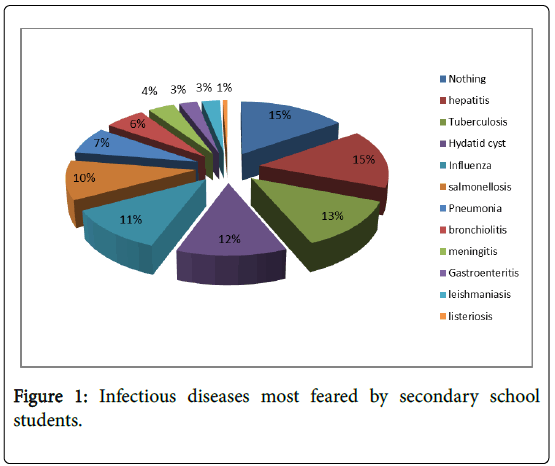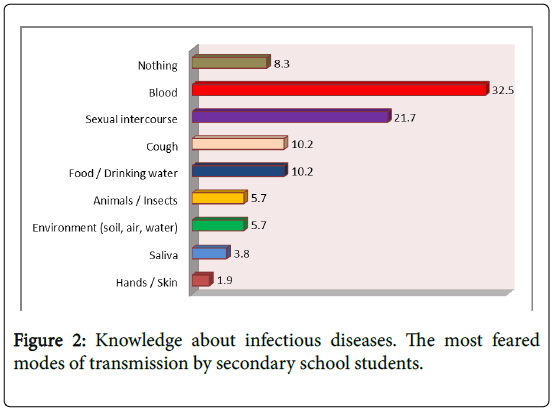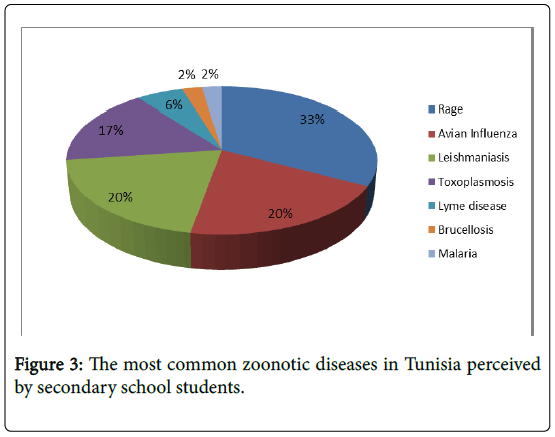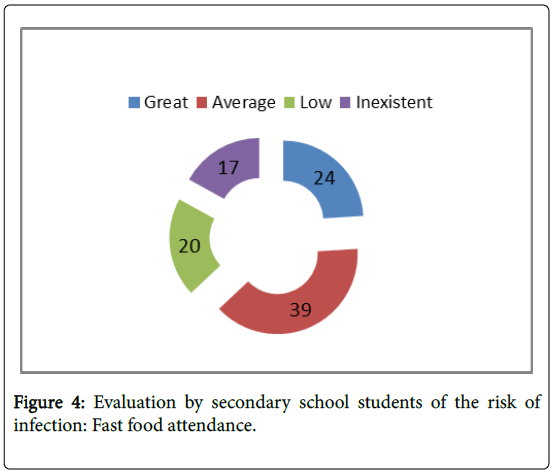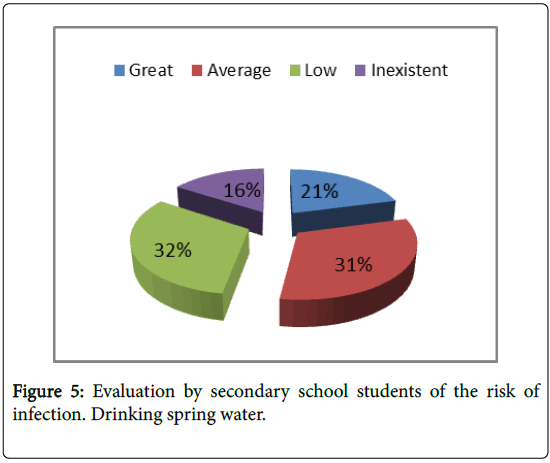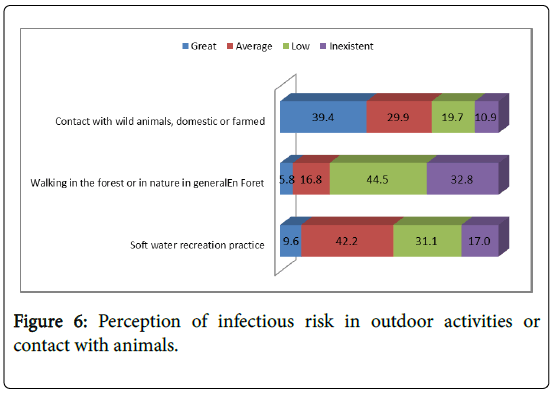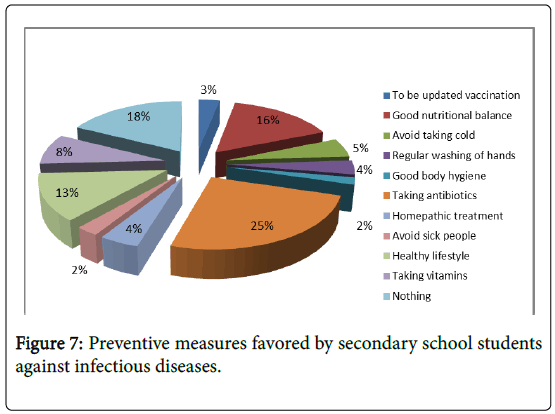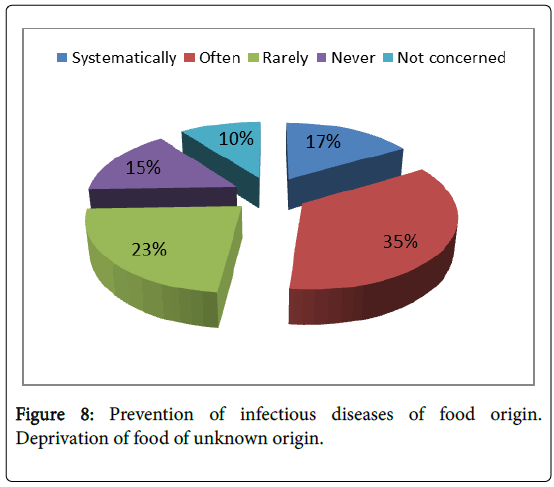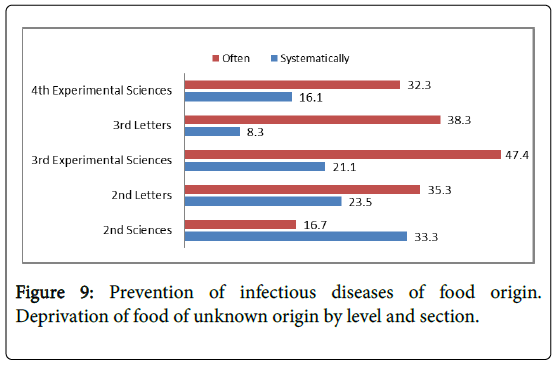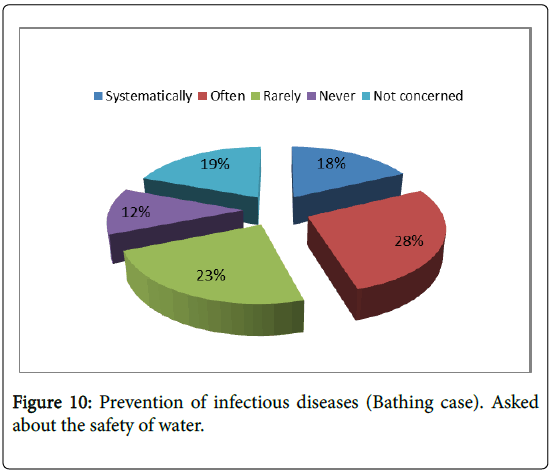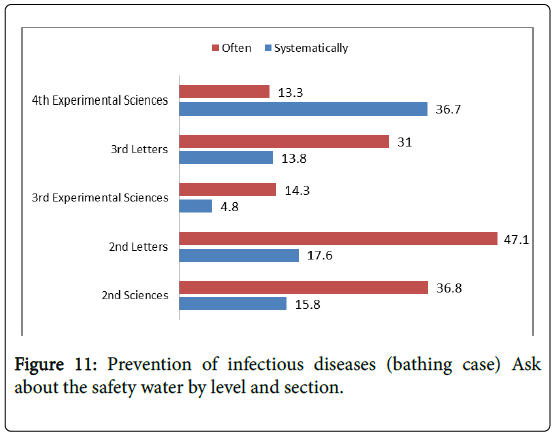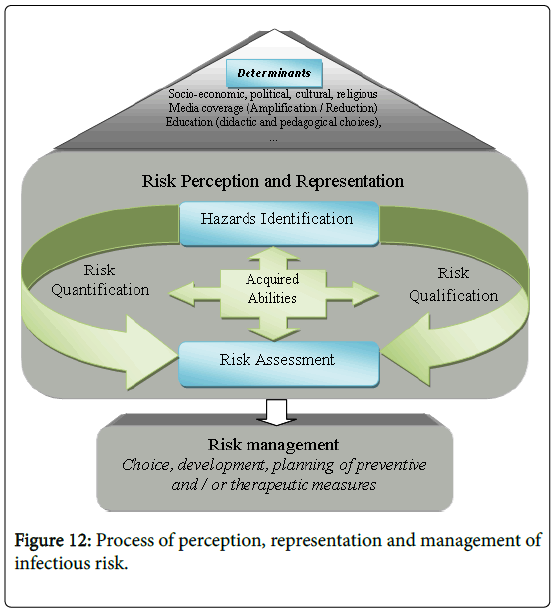Empowering Tunisian School Students to Prevent Food and Zoonotic Diseases
Received: 28-Sep-2018 / Accepted Date: 25-Oct-2018 / Published Date: 05-Nov-2018 DOI: 10.4172/2161-1165.1000357
Keywords: Health education; Food infections; Zoonotic diseases; Health promotion; School textbooks; Reasoned perception
Introduction
The health education participates in the progressive acquisition of knowledge and skills which will allow the pupils to make responsible choice regarding health. In this perspective, Tunisia accords to the health education a significant place among the missions assigned to the school system.
The Tunisian youth being confronted with new problems, new challenges and plagues. Indeed, the propagation of new parasitic and virology infections interrogates the role of school in the prevention and the promotion of health. How to allow a young person today, an adult tomorrow, to make responsible choice? Food and Zoonotic diseases are an example of epidemiological challenges faced by young Tunisians.
Food infections include pathologies of very diverse origins (bacterial, viral, parasitic), which are transmitted orally, either directly by the hands brought to the mouth after contact with a sick individual or an asymptomatic carrier, or from contaminated food or drink.
Some are only human and others are animal infections that are transmissible to humans. These are zoonoses. Not all zoonoses are foodborne. They can also be transmitted transcutaneously (through a skin lesion such as rabies) or via a vector (for example a tick or a mosquito like the case of leishmaniasis).
Presenting foodborne infections and zoonoses in a single component is based on the desire to avoid arbitrary separation or repetition: indeed, some zoonoses sometimes have several modes of transmission, including the food way.
Moreover, the food way can be at the origin of diseases that are strictly human, such as viral gastroenteritis and hepatitis A. Unfortunately, preventive actions remain limited against food and zoonotic diseases.
Ecological control actions are carried out by the Ministry of Agriculture and Environment in collaboration with the Ministry of Health. However, a better consideration of the didactical determinant and education would be strategic in order to optimize preventive measures. Indeed, the democratization of health measures in developing countries, through access to healthcare and health promotion closer to young people, allows optimal management of epidemiological risks.
In Tunisia, the introduction of health education in biological programs and textbooks aims at acquiring the knowledge and skills needed to prevent infectious risks. The textbook is a didactic help through which, the society can guarantee the didactic, scientific, educational and professional competence of the teachers. Besides, the influence of Textbooks seems even more dominating in developing countries [1,2].
The issue of new risks and emerging risks is ubiquitous in the media; students are constantly confronted with it more than by real experience. It thus seems likely that the perception of risks has increased enormously and sometimes in inverse proportion to their quantitative reality.
It should be recalled that health education covets the acquisition of scientific information, the adoption of good health practices and the development of skills and psychosocial skills, such as self-knowledge, self-esteem, respect for self and others, critical thinking, personal judgment, resistance to pressure (peers, media), and the ability to communicate.
It is clear that each infectious disease has its own representations for the students: gastroenteritis, listeriosis, salmonellosis, hepatitis A and leishmaniasis each carry their own lot of knowledge, explanations, fears, images.
Are there a number of common bases for young people to understand the interactions between humans and infectious agents? And could we build an educational strategy based on these bases? To answer this question, it was necessary to be able to analyze the profane knowledge of each infectious disease and to confront them with each other [3].
What is the place of the media and the school in terms of perceptions, attitudes, and behaviors? Should the role of the school textbook be re-evaluated in the national prevention and health promotion strategy in view of the training of school students who are actors in their health?
The perceptions, attitudes and behaviors of young Tunisians regarding infectious risks should be evaluated in order to optimize educational strategies.
In this article, will be studied:
• The perception of the food and zoonotic infectious risk,
• The knowledge of the diseases related to these risks and the declared preventive practices in the school population questioned.
The objective is to assess the abilities of Tunisian school students to perceive and manage the risks of food and zoonotic infection. A comparative analysis of these responses would confirm the impact of socio-demographic and didactic variables on the perception of food and zoonotic risk.
Material And Methods
This is a quantitative prospective study, by survey, which included 261 Tunisian school students from different educational levels and residents in different regions of the country.
A survey or health barometer elaborated in the form of a questionnaire for school students in the 9th year of preparatory schools and 2nd, 3rd year (Experimental and Letters section) and 4th experimental section of secondary schools. School students are asked on several themes in the term of the perceptions, attitudes and behaviors of different infectious risks, in the form of questions concerning zoonoses, seasonal flu, pneumonia, rhino-pharyngitis, vaccination and hygiene measures. In this work, we are interested in the case of food and zoonotic diseases [4].
It is clear that each infectious disease has its own representations for students: food and zoonotic diseases each carry its own lots of knowledge, explanations, fears, images. This survey aims to explore the current knowledge, attitudes, beliefs and behaviors of Tunisian school students regarding infectious risks.
Genesis of the survey: After having listed all the questions, it has become legitimate to explore both current and contextualized to the epidemiological profile of Tunisia, the survey aims at having data on the perceptions, representations, attitudes and practices of Tunisian school students on certain infectious risks and their mode of prevention: whether they are the object of a school study, and / or, an important media attention [5].
Our questionnaire is based on KABP-type surveys (Knowledge, Attitude, Behavior and Practice), used by social epidemiological studies to assess the perceptions, attitudes and behaviors of populations with respect to infectious risks in general. Given the subject of our study, we will adapt this tool to explore the perception of the school population for some examples of infectious risks [6]. In addition, the KVP model (knowledge, values, practices), which analyzes on the one hand the initial references of the transposition and on the other hand the programs and textbooks, we will be useful in order to evaluate the achievement of the aims of the education to health, conveyed by Tunisian life sciences curricula.
From a theoretical point of view, different approaches have been used to understand how risk perception is constructed. In a schematic way, three approaches are generally distinguished. The first developed by Slovic in 1975 and Fischhoff in 1978 is a psychometric approach to risk that proposes a cognitive stimulus/ personality/response model that is very focused on the individual dimension of risk and the use of risk assessment scales.
The cultural and societal approach to risk put forward by Douglas and Wildawsky in 1982 introduces the dimension of the social context and in particular the belonging of individuals to social groups as an explanatory dimension of risk perception [7]. Finally, the more recent constructivist approach proposes a theory of social risk amplification that emphasizes the notions of value systems and social imitation to which individuals are subjected.
In this study, the analysis focuses on general issues related to the perception of infectious risk and its place among other classes of diseases, the identification of practices perceived to be at risk of contracting an infectious disease, and preventive behaviors adopted by the school students and at the evaluation level their knowledge of infectious diseases.
Sampling
The population concerned, are Tunisian students aged between 14 to 23 years old, educated in preparatory schools and secondary schools in the North, Center and South of the country [8]. The sample was randomly drawn and representative of grade levels; 9th year preparatory school, 2nd and 3rd year (experimental sciences and letters section) and 4th year experimental sciences section (Tables 1 and 2).
| Numbers | Percentages | ||
|---|---|---|---|
| Total | 100 | 100 | |
| Sex | Male | 41 | 41 |
| Female | 59 | 59 | |
| Region | Tunis | 43 | 43 |
| Ben Arous | 57 | 57 | |
Table 1: Structure of the sample obtained in pupils 9th of preparatory school: by Sex and Region of residence, for an age group (14-16) (n=100).
| Numbers | Percentages | ||
|---|---|---|---|
| Total | 161 | 100 | |
| Sex | Male | 36 | 22.4 |
| Female | 125 | 77.6 | |
| 2nd Sciences | 19 | 11.8 | |
| Study and School level |
2nd Letters | 18 | 11.2 |
| 3rd Sciences | 25 | 15.5 | |
| 3rd Letters | 67 | 41.6 | |
| 4th Sciences | 32 | 19.9 | |
| Region | Kef | 30 | 18.6 |
| Seliana | 26 | 16.1 | |
| Kairouan | 23 | 14.3 | |
| Gafsa | 40 | 24.8 | |
| Tataouine | 42 | 26.1 | |
Table 2: Structure of the sample obtained in secondary school students by Sex, Study specialty, Grade level and Region of residence for an age group (16-22 years) (n=161).
Crossover variables:
The main variables used to characterize the knowledge, beliefs, attitudes and behaviors of the students surveyed are sociodemographic and didactic variables (sex, region of residence, study specialty and grade level, etc.).
Statistical method
The statistical analyzes were produced by the SPSS® software (version 20) allowing the calculation of the variances of the unequal probabilities in the sample and the statistics presented in this study. In the text, the threshold of significance retained is 5%. Thus, when a difference is declared significant, this means that the observed difference would have less than five chances to occur if one hundred different samples were randomly drawn from the observed population [9].
It is possible to conclude that the difference is probably not due to chance. In the sections dealing with its declarative data, bivariate analyzes were used to study the impact of sociodemographic and didactic variables on the perception and management of infectious risks.
Results
Perception of the infectious food risk
To identify the three infectious diseases that students feared most for themselves or their families, a list of eleven diseases was proposed, including four foodborne illnesses: gastroenteritis, hydatid cyst, salmonellosis, and listeriosis (Figure 1).
The 161 secondary school students responding to the question cited hydatid cyst as third (12.2%), salmonellosis fifth (10.3%), gastroenteritis ninth (2.6%) and listeriosis in the eleventh row (0.6%).
The 100 preparatory school students answering this question mentioned the same diseases last among a list of 9 proposed pathologies. Regarding the modes of transmission of infectious diseases (Figure 2), the most feared secondary school students, the causes: food, animal, environmental and physical occupy the last ranks after blood and sex with respectively: (10.2%), (5.7 %), (5.7%) and (1.9%).
The knowledge of diseases transmitted by animals by sociodemographic and didactics factors
To the question, what are the three most common diseases in Tunisia that can be transmitted by contact with animals or insects? The most commonly reported infectious diseases transmitted by animals or insects were rabies (32.8%), avian influenza (20%) ex-echo with leishmaniasis, toxoplasmosis (16.8%) (Figure 3).
The results show differences by factors:
• sociodemographic (age, region of residence)
• Didactics (School Level and Branch/Study Section).
The diseases declared as the most common in Tunisia differ from one region to another so the school students live in North Tunisia; Kef and Seliana recognize more Toxoplasmosis (55.5%), bird flu (50%) and rabies (44.5%). School students in Southern Tunisia report more rabies (73.2%), leishmaniasis (37.8%), bird flu (35.7%) as the most common animal-borne diseases in Tunisia.
The perception of the most common diseases in Tunisia that are transmitted by animals varies according to the level of education and the specialty of study so the proportion of 2nd year science school students is almost three times more numerous to mention rabies among the most common diseases in Tunisia than those of the 2nd Letters (31.3% vs. 11.1%), an inversely proportional trend to the next school level (15.4% vs. 39.2%).
Scientific levels would be more sensitive to the risk of avian influenza than literary ones (52.9% vs. 45.4%), let's still note a significant decrease in the perception of this risk for both the scientific and literary specialty regressing respectively (from 37.5% to 15.4%) and from (27.8% to 17.6%), a decrease which also concerns toxoplasmosis which passes for the scientific pathway from (25% to 15.4%) and from (27.8% to 13.7%) for the literary specialty.
Evaluation of quantification and qualification capacities of risk situations
Several concrete situations exposing school students to the risk of contracting a food or zoonotic disease were proposed in the questionnaire: it was a question, for the school student's questioned, of qualifying and quantifying the infectious risk of great, average, low or inexistent [10,11].
Fast food attendance: The first situation considered, likely to expose to an infectious risk, is the regular attendance of fast-food. Among preparatory school students who answered this question, almost a quarter say there is a great risk of contracting an infectious disease by regularly eating fast food (Figure 4). This proportion is higher for girls than for boys (27.1% vs. 19.5%, p<0.05).
Drinking uncontrolled water (spring water): The second situation is that drinking water that is not controlled by the Ministry of Health, such as spring water, wells, and filtered water (commercially clandestine) which would be potentially contaminated giving rise to oral transmission of digestive pathogens causing gastroenteritis or hydatid cysts.
Of the 100 preparatory school students interviewed about the origin of the water they drink daily; 24% mention drinking spring water, 12% filtered water, 16% tap water and 48% mineral water. 21% of them say there is a great risk of contracting an infectious disease by drinking uncontrolled water, 50% think the opposite and rate the risk as low or Inexistent [12].
21% of secondary school students surveyed consider that the risk of contracting an infection is great by drinking spring water, 31% consider risk as average, 48% rate it as low or inexistent. This food practice is not perceived as a risk for the school population (Figure 5).
However, the value given to this risk is variable according to the level and the specialty of education, therefore age. The 3rd sciences and literature school students are more likely to consider that the risk of contracting an infectious disease is great (76.5% vs. 16.1%, p<0.05), and more specifically according to the specialty of the respondents. Thus, the scientific levels (2nd and 3rd Sciences) are more sensitive to this risk than the literary levels (2nd and 3rd Letters) (62.5% vs. 30.1%, p<0.05).
Outdoor activities or contact with animals: Three situations were proposed as part of outdoor activities or contact with animals. The first was the soft water recreation practice such as fishing, swimming (Figure 6). The absorption of contaminated water would cause an oral transmission of digestive pathogens.
A second situation considered was contact with wild animals, domestic or farmed in which there may be a hand-held transmission of digestive pathologies, but also the transmission of non-food zoonoses via the mucocutaneous way (rabies, etc.). The third situation considered was walking in the forest or in nature in general, which may allow the transmission of certain non-food zoonoses (leishmaniasis, etc.).
Of the students who answered these questions, 39.4% of secondary school students state that there is a great risk of contracting an infectious disease by having contact with animals, 9.6% if swimming in fresh water and 5.8% while walking in the forest. More than a third of the respondents consider that there is no risk for each of these situations.
Assessment of the management of food and zoonotic infectious diseases by school students: Among the answers to the question concerning the means adopted in daily life to protect themselves from infectious diseases, two correspond to measures to prevent food diseases or zoonoses: regular hand washing, avoidance of animals.
While only 3.8% of secondary school students surveyed cited the regular washing of hands as a means of preventing infectious diseases (Figure 7), the declared behaviors with respect to daily hygiene reach higher rates.
In terms of frequency of hand washing, (36% of secondary school students surveyed vs 43% of preparatory school students) report washing them at least five times a day; and respectively (20% vs. 12%) less than 3 times a day, between 3 and 5 times a day (44% vs. 45%), between 5 and 10 times a day (18% vs. 28%), more than 10 times per day (18% vs. 15%).
Among school students who believe that there is an infectious risk in contact with animals, 0% say they avoid animals to protect themselves from infectious diseases.
Handwashing in different situations at risk of transmission of infectious diseases: Three different situations in which handwashing could prevent a manual foodborne infection were considered: before cooking, after being in the toilet or after stroking an animal.
School students were asked to answer the question: In each of the following situations in your daily life, tell me very frankly if you wash your hands routinely, often, rarely, or never.
• Thus, (61%) secondary school students claim to wash hands after going to the bathroom versus (89%) reported by preparatory school students.
• (41.9%) secondary school students claim to wash their hands before cooking.
• (66%) preparatory school students declare to wash hands after stroking a pet versus (55.7%) secondary school students.
This hygiene behavior (washing of hands) mentioned by secondary school students, varies according to the situations related to daily life, the difference is also significant according to the school level and specialty (p<0.05).
Thus, for the contact with domestic animals situation (72.2%) of the 2nd level science school students state that they wash the hands versus (47.1%) declared by the school students of 2nd Letters, as well as 3rd section Experimental Sciences and 3rd Letters.
Measures to prevent an infectious disease: A question was asked about depriving yourself of a food if there is a risk of 1 in 1000 of being infected by consuming it.
Fewer (17%) of secondary school students report that in this case they would deprive themselves of this food and (35%) say they do so (Figure 8).
School students who said they would deprive themselves of such a food are more often students in the scientific specialty (54.4% vs. 31.8%, p<0.05).
We note a decrease in the adoption of this prevention measure by moving from one level of education to the next, decreasing from 33.3% to 21.1% for the scientific levels and from 23.5% to 8.3% for the literary levels (Figure 9).
To determine if, in certain circumstances, preventive measures were taken to protect themselves from the risk of infection, school students were asked if they inquired about the safety of water before bathing.
Among the respondents (19%) of secondary school students did not feel concerned by the question, fewer (18%) say they learn and (28%) (Figure 10).
The proportion of school students declaring request information is more important in the literary section than the scientist considering that there is an infectious risk when swimming (31.4 % vs. 20.6 %; p<0.05) (Figure 11).
Discussion
The different theoretical approaches to risk perception can be used to interpret the results of this survey. The subjective and emotional dimension of risk is superimposed on other dimensions such as belonging to social groups and anchoring in specific value systems.
The results show that the perception of food and zoonotic diseases by school students depends:
- Geographical proximity,
- Gender,
- Media coverage and
- Didactic variables (School level: Study specialty/Section).
All the factors coexist objectively and interact with the subjectivity of each individual. Convergence is first of all a perception either:
Spontaneous, is oriented towards normalism under pressure from peers, family and the media. The risk of an epidemic of fear (panic phenomenon) is therefore significant. The welfare state and the health authorities would be the only recourse, dictating standards of good health and prescribing hygiene measures and adequate behavior in accordance with epidemiological knowledge. Verticality (health professionals/patient) is required. The feeling of fear is the only one implemented in the control of decision-making.
Reasoned that personal qualifications take precedence over social and sometimes sanitary conformism. The positivism of a statistical knowledge not always accounting for the originality of the individuals, microbial dynamics and the variation of the contexts.
Hence the complexity of the infectious risks, evolves towards more relativism. The emancipation and empowerment of the students in the face of infectious diseases is reinforced by the development of his psychosocial skills. We believe that this is a condition for the acquisition of reasoned perception abilities (qualification and quantification of infectious risk) and management (choice and planning of adequate preventive strategies) (Figure 12).
The relation (patient/doctor) is more interactive so they become partners in the therapeutic path.
In the first case the spontaneous perception is followed by a hazardous or intuitive management of infectious risks.
In the second case the reasoned perception is then relayed by an optimal thoughtful management. The regulation and the implementation of the strategies of prevention (search of information, measures of avoidance, personal hygiene, consultation of doctor, homeopathy, protection of others) is not made only by fear but especially following to a reflection evaluating the consequences of the decisions to be taken. The knowledge acquired is mobilized in everyday life.
Thus, actions such as:
- Avoid: night irrigation, drink suspicious water, consume contraband food, contact of animals in risk situations,
- Move manure away from dwellings,
- Purge stagnant water,
- Ask about the quality of water before bathing,
- Installation of septic tanks,
- Wear impregnated masks,
- Alert the health authorities in the event of an epidemic,
- Be aware of climate issues,
- To know the importance of rational management of water and soil resources,
- Protect the environment individually and collectively,
- Medical and therapeutic autonomy (public/private vaccination, taking antibiotics, consultation of doctor/nurse/pharmacist/ homeopath/marabou)
Then the evolution of a passive student (who suffers) to a reflexive practitioner (who acts) is dependent on his empowerment (empowerment or emancipation). It is the role of promotion to health through school education through life sciences.
The results of the survey conducted among Tunisian secondary school and preparatory students show that the impact of the content allocated to the prevention of infectious diseases is real (the perception of risk is dependent on didactic variables). However, in our case health education does not allow to develop a reasoned perception of the infectious risk and consequently optimal management of infectious diseases.
The knowledge acquired is punctual and the perception of risk in some cases is inversely proportional to the transition from one grade level to the next, it is regressive. Indeed, school students are relatively unable to:
- Judge the presence and dangerousness of certain food and zoonotic diseases.
- Mobilize acquired knowledge specific to each of the diseases mentioned.
- Apprehend the infectious risks in the different situations proposed.
- Adopt appropriate preventive measures for each infectious risk.
- Estimate the dangerousness of certain risky behaviors.
This survey focuses on the didactic dimension. In Tunisia, the health education of the youngest is conveyed mainly by the textbooks of the Sciences of Life and the common ground along the school path in preparatory school then specific according to the orientation of the student towards scientific or literary sections. Themes and chapters studying concepts in relation to infectious diseases differ according to the specialty of school study (section and grade level of the student). We are interested in studying the impact of its variables on students' perception of infectious risks, their modes of transmission and the means of prevention to be adopted and their evolutions by going from one grade level to the next. Media coverage and social amplification for certain infectious diseases also play a role in the construction of risk perception among students.
In this survey, infectious food diseases (gastroenteritis, salmonellosis and listeriosis) were ranked last among infectious diseases most feared by school students, with the exception of hydatidosis, which was mentioned in third place.
Punctual knowledge influenced by the media and didactic content dominated by the biomedical model
Concerning the perception of the infectious food risk, it is rather surprising to note that the school students questioned do not fear them whereas these last ones are very often dangerous; it seems possible that over-mediatization of infectious risks concerning sexually transmitted infections (AIDS), prevention campaigns of the Ministry of Health over the years, and textbooks designed according to a biomedical model focused on the transmission of information and not on the development of psychosocial skills, have led to an undervaluation of its risks.
Its factors explain their perceptions of modes of transmission. The causes of infections: food, animal, environmental and body are at the bottom of the list after blood and sex.
Although the content of the Life Sciences textbooks is rich in lessons evoking the prevention of the risk of food infections, however, the educational style (informative/injunctive) and the paternalistic (moralizing) discourse seem insufficient to develop an objective perception of infectious risks of food, more common in the daily lives of learners and often dangerous.
In addition, the fears of the school students surveyed related to particular situations were frequent for the contact with the animals, less for the bathing and almost none for the walks in forest. The impact of the didactic variable seems obvious given the many examples of animal infections (Toxoplasmosis, oxyruose, etc.) mentioned in life science textbooks. However, learners seem unable to adapt to new situations (not mentioned in textbooks), they are neither critical nor autonomous in the face of infectious risks.
Situation 1- Regular meals at Fast-food: When it comes to the infectious risks associated with regular meals at fast-food, among preparatory school students who answered this question, almost a quarter say there is a big risk of contracting an infectious disease by regularly eating fast food. This proportion is higher for girls than boys (27.1% vs. 19.5%, p<0.05).
It is difficult to find an interpretation of this trend, one of the possible hypotheses is linked to the increased dependence of girls on their mothers, whose traditional role as foster mothers and guarantors of the health of the family. Indeed, this social role can lead them to be wary of taking meals outside and to allocate to the restaurant (fast food) infectious risks that would not exist at home, the house being perceived as a protective space and the exterior as that of danger.
Situation 2-drinking uncontrolled water: Tunisia is suffering from the last few years of drought and the frequent shortage of drinking water, from where most rural but also urban populations are directed towards uncontrolled sources of supply.
In this context a second situation envisaged, likely to expose to an infectious risk, is the fact of drinking an uncontrolled water by the Ministry of Health, such as spring water, wells, and water filtered (clandestinely marketed) which is potentially contaminated and gives rise to oral transmission of digestive pathogens causing gastroenteritis or hydatid cysts.
Of the 100 preparatory school students interviewed about the origin of the water they drink daily; (24%) report drinking spring water, (12%) filtered water, (16%) tap water and (48%) mineral water.
(21%) say there is a big risk of contracting an infectious disease by drinking uncontrolled water, (50%) think the opposite and rate the risk as low or non-existent.
By drinking spring water, (31%) rate the risk as average, (48%) rate it as low or nonexistent. This food practice is not perceived as a risk for the school population.
Knowledge of zoonotic diseases: media, sociodemographic and didactic impact
The question of knowing the three most common diseases in Tunisia that can be transmitted by contact with animals or insects seems to have been difficult to understand.
The fact that a large proportion of school students did not answer the question and that another party mentioned infectious diseases that are absent in Tunisia or not zoonotic could reveal a lack of knowledge about what is really an infectious disease, linked to animals.
The most cited zoonoses were indicative of the immediate impact of the media and of the persistence, in the general public and in the school public, of knowledge that is currently out of date since the incidence of some of its diseases has significantly decreased in our country.
Indeed, rabies, still not eradicated in Tunisia, however the efforts of health authorities to fight against this infectious risk has led to a decline in cases of human contaminations.
In the minds of the public in general and school students in particular, frequency and severity can be notions that are not always well distinguished. The effect of the media coverage of bird flu and the risk of an influenza pandemic has certainly played a role in the knowledge of this disease, which is cited by 20% of the school students surveyed.
Leishmaniasis, a tropical disease rarely mentioned, is no exception and is highly publicized and being the subject of a media debate during the years 2016 and 2017 has allowed an awareness of this disease among young audiences.
• The sociodemographic variables would have an impact on the perception of zoonoses, thus the diseases declared as the most common in Tunisia different from one region to another so the students reside in North Tunisia; Kef and Seliana recognize more Toxoplasmosis (55.5%), bird flu (50%) and rabies (44.5%). Students in southern Tunisia report more rabies (73.2%), leishmaniasis (37.8%), bird flu (35.7%) as the most common animal-borne diseases in Tunisia.
• The didactic variables would have an impact on the perception of zoonoses in Tunisia, varying according to the school level (specialty / Section). Indeed, the proportion of 2nd year science school students is almost three times greater to mention rabies among the most common diseases in Tunisia than those of the 2nd Letters (31.3% vs. 11.1%), a trend inversely proportional to the next school level (15.4% vs. 39.2%).
Scientific levels would be more sensitive to the risk of avian influenza than literary ones (52.9% vs. 45.4%), let's still note a significant decrease in the perception of this risk for both the scientific and literary section regressing respectively (from 37.5% to 15.4%) and from (27.8% to 17.6%), a decrease which also concerns toxoplasmosis which passes for the scientific pathway from (25% to 15.4%) and from (27.8% to 13.7%) for the literary section.
The limits of the biomedical model, characterizing the contents of life science textbooks, explain this regression in the perception of the infectious danger (qualification and quantification of risks), the knowledge acquired by the school students, concerning factors, symptoms and hygiene, is punctual.
Infectious Risk Management
Hand hygiene: first prevention measure badly apprehended!
When the means used to avoid infectious diseases were addressed, the students surveyed said (3.8%) use hand washing. This proportion is very low compared to the important role this method plays in preventing the transmission of food and zoonotic diseases, and it is likely that students underestimate handwashing as a means of prevention. Paradoxically, health education of the sanitary (hygienist) type conveyed in the potential curricula of the life sciences is insufficient to make handwashing accepted as a preventive measure against the infectious risks of food. The management of the infectious risk in the present case is insufficient.
When handwashing was offered in situations such as after going to the bathroom, almost all preparatory school students and more than half of secondary school students reported doing it , less than half before preparing meals.
Surprisingly, there are more students who opt for routine handwashing after stroking a pet; (66%) preparatory student’s vs. (55.7%) secondary school students, a behavior that could be explained by:
- The frequency of examples related to the theme of food hygiene cited in the textbooks of Life Sciences,
- A behavioral mimicry (family),
- The desire for acceptability and social conformity
We believe that these statements probably overstate the reality of the practices. Indeed, it is very likely that a social desirability bias had an impact on personal hygiene responses. Some of the students responded by adopting certain practices relating to the systematic washing of hands, not according to their daily practices, but rather according to socially expected behavior.
Confusion between preventive and therapeutic measures
25% of school students report the use of antibiotics as a preventative measure against infectious diseases. The cultural and societal approach to risk puts forward by Douglas and Wildawsky in 1982 introduces the dimension of the social context and in particular the belonging of individuals to social groups as an explanatory dimension. In the case of influenza or gastroenteritis, most Tunisian low- and middle-income citizens buy antibiotics without consulting a doctor and without a prescription. This social practice clearly influences the perception and management of infectious risks by Tunisian school students. Hence, the confusion between preventive and therapeutic measures.
In Life Science textbooks, it is common to encounter consult a doctor as soon as the first signs of illness appear. However, this informative-injunctive style and the sometimes paternalistic and moralistic discourse do not resonate with the younger ones. Several examples of infectious diseases are included in the educational path of Tunisian school students in primary and secondary education, but the knowledge acquired is punctual and not mobilized in real life.
The dominant biomedical model of health education doesn't allow development of the psychosocial skills needed to discuss, argue and convince parents that infectious diseases are not all bacterial. Behaviorism and the use of fear as an unconscious mechanism of decision-making is not adequate to the socio-cultural profile of today's students.
Avoidance: prevention measure not envisaged by school students
Despite efforts by health authorities to limit people's access to food of unknown origins, however, the socio-economic context postrevolution (2011) to increase the smuggling of foodstuffs and the proliferation of a parallel market less costly for unsophisticated consumers with reduced purchasing power.
School students, who are more and more autonomous during the day, suffer the consequences of this food smuggling, hence the situation envisaged the fact of depriving oneself of a food if there is a risk of 1 in 1,000 being infected by consuming it.
Fewer (17%) of secondary school students state that in this case they would deprive themselves of this food and (35%) say they do so often.
The preventive component as presented in the Life Sciences Manual does not allow school students to understand the food-borne infectious risks, which are often complex. Injections and the prescription of hygiene measures are insufficient to develop a reasoned perception in the learner to resist the multidimensional pressures (economic, media, peers).
Inquire as to the safety of the water
Concerning the fact of inquires about the safety of water before bathing in fresh water: It is a practice at risk but frequent in the rural area close to wadis and dams, and urban environment (swimming pool not controlled). Although this notion can be very varied (simple search for a sign, ask the question to the parents or real approach with the municipality, etc.), the proportion of school students declaring to do it seems weak. It is probable that there is also a social desirability bias corresponding here to the respondent's desire to appear as a responsible person.
The biomedical model is far from promoting student empowerment. However, prevention against infectious risks requires the learner to be independent, critical, creative and responsible in his environment and with his peers.
Conclusion
It seems clear, in this case, that positivist epidemiological knowledge has influenced the content of infectious disease prevention. The limits can be transposed into prescribed and potential curricula via the biomedical model. The analysis of life science textbooks also shows conceptions subject to the paradigm of simplification (reductive) according to a linear logic of cause and effect.
This analytical approach does not favor the prevention of complex and multi-factorial infectious risks. Indeed, infectious diseases are often invisible, unpredictable and taboo for some of them that require a systemic approach favorable to the apprehension and emancipation of school students in the face of infectious risks.
We believe that the content is far from promoting the development of psychosocial skills and empowerment essential: the reasoned perception (qualitative and quantitative assessment of the danger) and optimal management of infectious risk in often unprecedented and complex situations.
In fact, the achievement of the preventive aims of health education in the face of infectious diseases would depend on:
- Development of a clear competency framework for health.
- Evolution of the current biomedical model towards the promotional model.
- Adherence to a participative style of education.
- Update of the infectious examples studied to current and future epidemiological challenges (case of Leishmaniasis, Hepatitis A).
- Content update and integration of the concept of human microbiota.
- Contextualization of the studied infectious examples to the social practices of reference.
- Reduction of the vertical disparity between the different specialty and sections.
- Consider a multidisciplinary health education.
- Promote project and investigation pedagogies while involving families, civil society and health professionals.
- Sensitization of educational actors to the concepts and aims of health education.
- Reconcile the concepts of health education with those of the environment (environmental impacts and health issues).
Acknowledgments
This study is the result of a collective work. We are grateful to the teachers and school students who participated in the dissemination and collection of the mentioned data. The collaboration with researchers from the Institute Pasteur Tunis was a source of inspiration and essential expertise.
Declaration of interest
The authors report no conflicts of interest. The authors alone are responsible for the content and writing of this article.
References
- Clément P (2014) Conceptions, représentations sociales et modèle KVP. HAL 16: 55-70.
- Douglas M, Wildawsky A (2010) Risk and culture: An essay on the selection of technical and environmental dangers. International Review of Public Administration 15: 81-82.
- Fischhoff B, Slovic P, Lichtenstein S, Read S, Combs B (1978) How Safe is Safe Enough - A psychomeric study of attitudes towards technological risks and benefits. Policy Sciences 9: 127-152.
- Hamida AB, Fakhfakh R, Miladi W, Zouari B, Nacef T (2005) La transition sanitaire en Tunisie au cours des 50 dernières années. East Mediterr Health J 11: 181-191.
- Kermisch C (2012) Vers une définition multidimensionnelle du risque. Vertigo 12: 2.
- Khzami SE, Agorram B, Selmaoui S, Clement P, El Hage F, et al. (2010) L’éducation à la santé: analyse comparative des manuels scolaires de biologie de 3 pays méditerranéens. Education et Formation 2: 57-67.
- Mansour NB, Skhiri H, Hsairi M, Aounallah-Skhiri H, Hajjem S (2006) Causes de décès en Tunisie: estimation des années de vie perdues 20: 257-264.
- Kasperson RE, Kasperson JX (2008) The Social Amplification and Attenuation of Risk. The Annals of the American Academy of Political and Social Science 545: 95-105.
- Saab O, Berger D, El Hage F (2013) L'éducation à la santé en milieu scolaire au Liban : d’une approche analytique biomédicale vers une perspective écologique biopsychosociale. Etude curriculum, des manuels scolaires libanais de Sciences de la Vie 50: 95-110.
- Setbon M (2005) Perception et gestion du risque. EDP Sciences 23: 123-136.
- Slovic P (2011) Perception of Risk. American Association for the Advancement of Science Stable 236: 280-285.
- Vergriette B (2006) Perception du risque et participation du public. Afsset.
Citation: Maaoui F, Moumni I, Mouelhi L (2018) Empowering Tunisian School Students to Prevent Food and Zoonotic Diseases. Epidemiology (Sunnyvale) 8: 357. DOI: 10.4172/2161-1165.1000357
Copyright: © 2018 Maaoui F, et al. This is an open-access article distributed under the terms of the Creative Commons Attribution License, which permits unrestricted use, distribution, and reproduction in any medium, provided the original author and source are credited.
Select your language of interest to view the total content in your interested language
Share This Article
Recommended Journals
Open Access Journals
Article Tools
Article Usage
- Total views: 5086
- [From(publication date): 0-2018 - Nov 18, 2025]
- Breakdown by view type
- HTML page views: 4201
- PDF downloads: 885

